| Tokyo Main Camp Omori |
Main Page Main Camp List
| Name:
Tokyo
MAIN CAMP (OMORI) (NIPPON TSUUN) Location: TOKYO-to, OMORI-ku, IRIARAI-machi - This was a man-made island constructed for the purpose of isolating the POWS. Constructed mostly by men from Shinagawa Camp. Satellite (Shinagawa, Location #1) Satellite (Omori) Relief map of area Time Line: 12 Sep 1942: First known as Shinagawa POW Camp, located at Shinagawa-ku, Keihin Unga Kensetsu office 25 Sep 1942: Renamed Tokyo POW Main Camp. 13 May 1945: Influx of POWS from Tok-13B Asano Docks 20 Jul 1943: Moved to Omori-ku, Iriarai-machi 1 Aug 1943: Shinagawa Hospital established as separate entity. Sept 1945: Rescue effected Photographs: Dozens of pictures, includes many classic POW images Links to POW pages:
Col. Richard T. King, Jr. Flight CO, 500th Bomb Group (B-29) shot down over Tokyo, 3 Dec 1944 Robert Goldsworthy- pilot in King's flight Raymond "Hap" Halloran Bombardier/Navigator, 878 BS 499 Bomb Gp, shot down, 27 January 1945. OUTSTANDING photos. UCLA Photo Exhibit: Noted photographer John Swope- classic pictures of rescued POWs. William A. Dixon - B-25
navigator/bombardier, Attu
Herewith are the facts as I know them of my father’s imprisonment by the Japanese from September 9, 1944 to August 29, 1945: 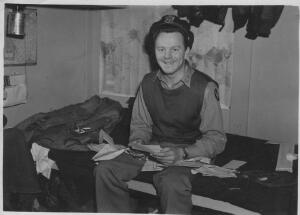 As of approximately June 1944, my father, William A. Dixon, was a navigator/bombardier aboard a B-25 stationed on Attu in the Aleutians with the 77th Bomber Squadron, 28th Bomb Group of the 11th Air Force (Corps). Most missions targeted Japanese shipping and garrisons in and around Paramushiru in the northern Kuriles. Members of the flight crew were Pilot: 2nd. Lt. Albert D. Scott of Weleetka, OK, Co-Pilot: F/O William (Vic) Gallo of Apollo, PA, Navigator/Bombardier: 2nd. Lt. William A. Dixon of Mountain View, NJ (AKA: Lincoln Park, NJ), Gunner: Sgt. Reynald P. Isrussi of Cleveland, OH, Gunner: SSgt. Carmen DiOrio of Chicago, IL, Flight Engineer: SSgt. Arthur O. Knipe of Haverhill, MA. They were shot down on their 10th mission on September 9, 1944. They attacked a five ship convoy off Paramushiru (2 gunboats, 2 freighters, 1 tanker) They took two runs on a freighter. The first was a strafing run and the second was to be a bombing run. Ack ack fire from gunboats hit their right engine on approach which resulted in failure to gain sufficient altitude to clear freighter mast which sheared off tail fins and they tumbled into the sea. All but DiOrio and Knipe survived crash. Gallo, Isrussi, Scott, and Dixon picked up by fishing boats and brought to Paramushiru and kept in caves, interrogated by Japanese officers daily for 10 days. They were then put aboard two Japanese freighters (ironically the same ships they attempted to bomb.) in solitary confinement. My father was held in a cargo hold, naked except for a smelly fur jacket, a sanitary bucket, container of water, and dog bones. The journey lasted four days and they docked at Hokkaido where they took a train to an airport where they boarded a captured American C-47 to Yokohama and the Ofuna interrogation camp. It was there that he first met “Pappy” Boyington, the Marine ace, who also subsequently was imprisoned at Omori along with Commander O’Kane of the USS Tang. After the first of the year they were shipped by truck and train to Omori, a registered camp outside Tokyo. While in captivity my father was interrogated, beaten, starved, and abused until liberated by the US Navy on August 29, 1945. He was too weak to join in the celebration as he was down to 90 pounds and suffered from many afflictions such as carbuncles, boils, hepatitis, yellow jaundice, dengue fever, dysentery, malaria, beriberi, and anxiety neurosis. He was hospitalized for several weeks aboard the “USS Benevolence” for a few weeks, flown out of Tokyo to Guam, then to Hawaii, and then San Francisco. -- Bill Dixon (Jr.)
See also this excerpt from William Dixon's memoirs, courtesy of Bill Dixon Jr. List of Corsair pilots (US and British) at Ofuna or Omori in August 1945 (courtesy of Irons): MAJ. Gregory Boyington VMF-214
Lt. Donald Carlson VMF-124 Lt. William "Country" Landreth VMF-452 1Lt. Samuel B. Smith VMF-312 Lt. John P. Stodd VMF-214 Ens. James Bouldin VBF-83 Lt. James Cass Dixon VF-84 Ens. John M. Petersen VBF-6 Lt. jg. Edward Dixon, Jr. VF-85 Lt. jg. H. Shroff VF-85 Ens. John M. Chapman VBF-85 Lt. jg. John C. Dixon VBF-85 Lt. Donald Cameron 1833 NAS (British) Niigata 5-B: Maj. Donald Winser Boyle VMF-212 List of pilots and airmen from USN Task Force 38 Fast Carriers during the period 3Jan45 to 22Jan45 during attacks over Luzon and Formosa: Lt. Hubert Todd Houston VF-4 Omori
Lt. Minos D. Miller, Jr. VF-81 Omori Lt. jg. Wm. Thomas Ross, Jr., VT-20, Omori Lt. Charles V. August VF-44 Omori Lt. Ralph Palmer and his airman, Adelbart R. ring ARM3c VB-80 Omori Jean Felton Balch ARM3c VB-3 Omori Alvin W. Hughes ARM3c VB-7 Omori |
Background
Info: Man-made island constructed by POWs for the purpose of isolating POWS, especially the "special prisoners," where Louis Zamperini and many Wake Island Marines were held as well as the Commanders of the USS Grenadier, the USS Houston, and USS Tang. Today it is a Sasakawa-owned motorboat racing venue, the Heiwajima Boat Stadium, with a park complex including movie theaters and a hot spring. Heiwajima [Peace Island] - Jima means island, the island that the Allied POWs built (1-1-1 Heiwajima Ota Ward, Tokyo). Heiwajima Kannon - past the entrance to the boat races, a small fenced-off area of greenery featuring a statue of Kannon (the goddess of mercy) and a signboard in Japanese with some euphemistic references to the brutal history of this spot. Among the information not provided by the signboard are: 1) how many POWs perished here, 2) how many POWs built the original island, and 3) that wartime Prime Minister Hideki Tojo was briefly held here when he was first arrested as a war criminal. Article in 2015: US POWs Come Back to Japan to Recall Their Wartime Ordeals Rosters: Americans British and Allies Deceased: Shinagawa-Omori [Japanese site] Original Omori rosters - POW deaths and POWs at time of liberation (RG 389 Box 2175A); American, British, Australian, Canadian, Dutch, Estonian, Italian, Norwegian, New Zealand Tokyo camps rosters, all nationalities (RG 407 Box 115) - contains rosters of many Tokyo camps (camp numbers not listed) Tokyo camps, death rosters, all nationalities (RG 407 Box 189) Misc. rosters and documents for Tokyo camps (RG 407) - TXT file of contents ASST. ROSTERS FOR OTHER CAMPS: (The following rosters are for camps for which we do not have dedicated webpages.) Dutch roster for all(?) Tokyo camps (RG 407 Box 113) Roster for Tokyo #6-B Suwa (RG 407 Box 115) - American, British, Dutch, Canadian, Australian, Chinese, Czechoslovakian (Related for Suwa Camp - Job van Belzen Diary (courtesy of van Belzen, 2007-02-18) Roster for Tokyo #11-B Kawaguchi (RG 407 Box 115) - American civilian, Italian Navy personnel. Note: This camp was only utilized from July to September 1945. Roster for Tokyo #14-B Shibaura (RG407 Box 115) - British, American, Dutch, Australian Sendai, Hakodate, Tokyo patient rosters (RG 407 Box 167) Folder 3: List of Patients:
Sendai Main
Camp, Omi Honshu Island Camp 13-B, Hakodate and Tokyo Main Camp.
1943-1944. Includes American, British, Canadian, Australian,
Dutch, New
Zealander, Norwegian, Italian, Chinese, Hong Kong and unknown
(possibly
Estonian) military and civilian patients.
Folder 4: Hospital Roster - Tokyo Group - Omori Camp, including Yokaichi Sub-Camp. May and July, 1945. Includes American, Dutch and British patients. Folder 5: List of Patients: Sendai Branch Camp #1, Hakodate, Tokyo Main Camp. Duplicates of some rosters in Folder 3. Includes American, British, Canadian, Australian, Dutch, New Zealander, Norwegian, Italian, Chinese, Hong Kong and unknown military and civilian patients. Folder 6: Particulars of patients and staff - Morioka Army Hospital, Sendai POW Camp. Contains duplicates of Folder 3. Includes U.S., British, Australian, New Zealander, Canadian, Norwegian and Dutch patients. Folder 7: Hospital Roster - Sendai POW Camp, Morioka Army Hospital. Duplicates of some rosters in Folder 3. Includes American, British, Canadian, Australian, Dutch and New Zealander patients. Folder 8: List of patients - Sendai POW Camp. Includes American, British, Australian, New Zealander, Canadian, Norwegian and Dutch patients. 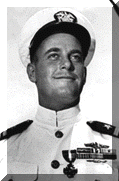 Richard Hetherington O'Kane Recipient of the Medal of Honor Commander of USS Tang Some important archival documents regarding POW Louis Zamperini:
Special: The story of Delbert Miller, shot down over Japan and managed to survive [External Link] Robert Ross, Pvt, Royal Scots - photo - Red Cross document - Index card front, back (courtesy of Raymond Ross) "Here is a photo of my
grandfather and a Red Cross doc. He was catcher at Hong Kong and
sent
to OMORI Tokyo Base Camp #1."
Lt. Lewis M. Bush Report - DOC file (transcription courtesy of Scott Proudfit) on conditions at the camp, including political; mentions Watanabe "The Bird," aka "Mr. Brown" (Bush wrote about his experiences in his hard-to-find book, Clutch of Circumstance). TOKYO_POW_transfers_Kenpeitai_RG331Bx1851 - US airmen missing in action near Tokyo; final roster of Omori POW Camp (US, British, Australian, Dutch, New Zealand, Canadian, Dutch East Indies,Norwegian, Estonian, Hong Kong Defense Corps); transfers from Kenpeitai to Tokyo camps, hospitals, Shibuya Military Prison, via Ofuna camp, Koishikawa Military Cemetery; transfer of surviving air crew members; Tokyo Kenpeitai medical officers; list of US dead airmen; Koishikawa cemetery sketch; alpha list of American POWs transferred TOKYO Kenpeitai Records (RG 331 Box 1850) - Asst. files on organization of Tokyo Kenpeitai (Kempeitai). See this text file for contents; note that folder covers and only a few pages from each folder were photographed. TOKYO Kenpeitai (RG 331 Box 1851) - Asst. files on organization of Tokyo Kenpeitai (Kempeitai) POW transfers from Java to TOKYO (RG 407 Box 115) - List of 190 American, British, Australian, and Dutch Recommended Books: Unbroken by Laura Hillenbrand - story of Louis Zamperini, who spent time at Omori from Sept. 1944 to Feb. 1945. This book is a must-read! For a more complete story of his life after conversion, read his first book, Devil At My Heels (1956), and later re-published (2003).
Proof
Through
The Night - Excellent
story of a B-29 pilot shot down on the first raid (Yawata) over
Japan.
A good insight into the savage treatment of pilots. [See
our review] Landing
was the Easy Part
by Edward Pappert - "Contains the text of a letter from Corporal
Roy F.
Dandridge, 1st Bn. Middlesex Regiment, British Army, to the
pilots of
VF-83, USS Essex CV-9. He gives thanks to the pilots for their
airdrops. Three paragraphs total. It's a great piece of history
(page
119). Ed flew with VF-83/VBF-83 through its tour in '45. His
book
contains a few other very brief paragraphs about the 'mercy
hops' they
flew and includes a picture of Camp 1-B taken during one of
these
missions. Lt. John E. 'Jack' Freemann, Jr. of VB-6 (USS
Hancock
CV-19) flew some of the mercy missions over Omori, etc., in late
August
'45. Very exciting to hear this old pilot describe flying over
Omori
and seeing the sign 'Pappy Boyington Here'." |
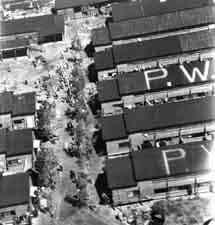
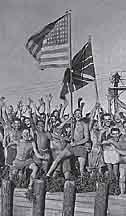
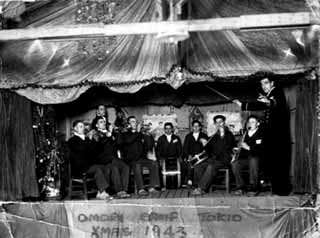
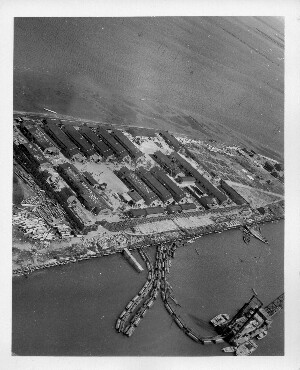
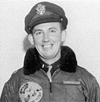 Hap's
War
Hap's
War